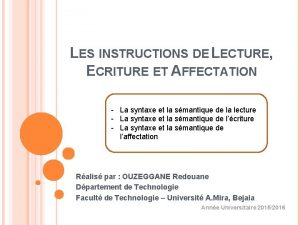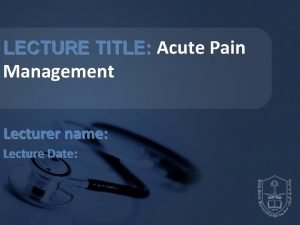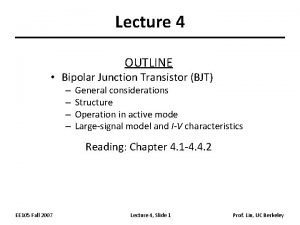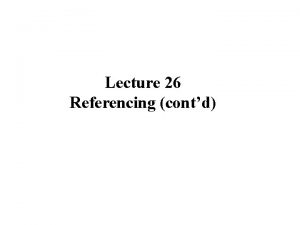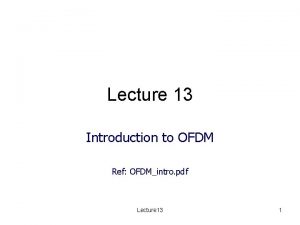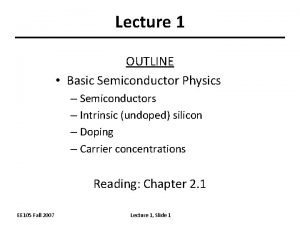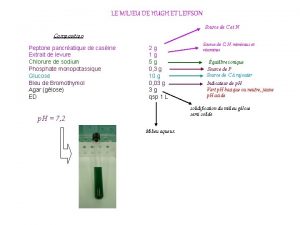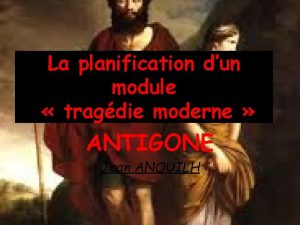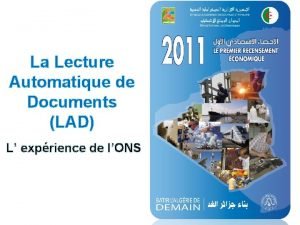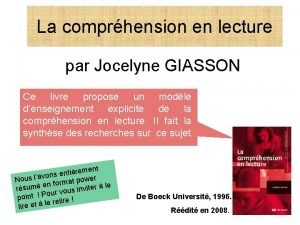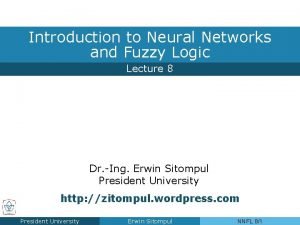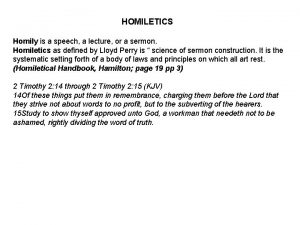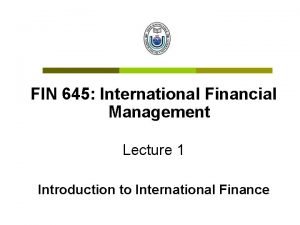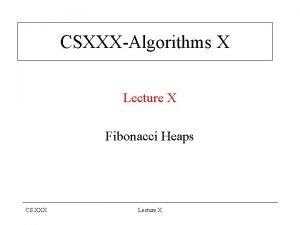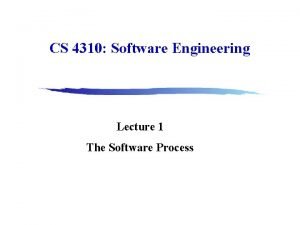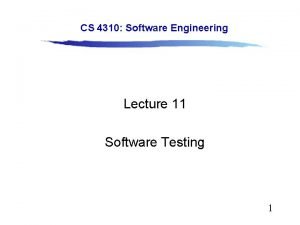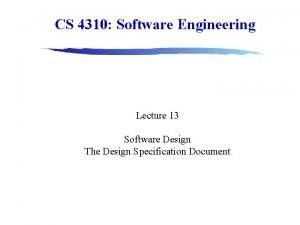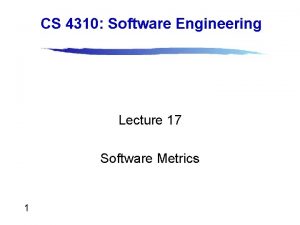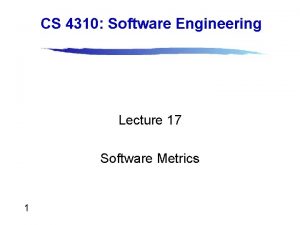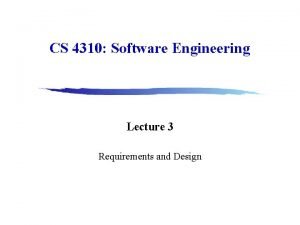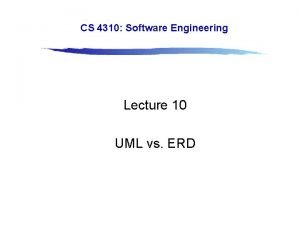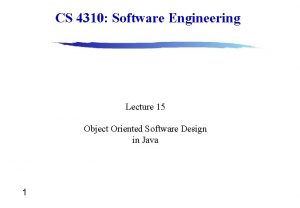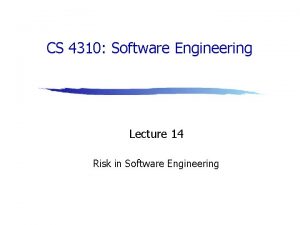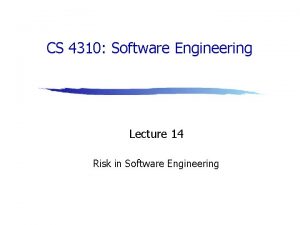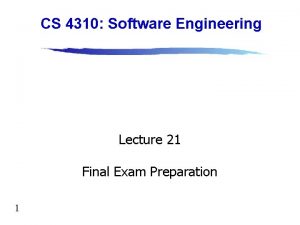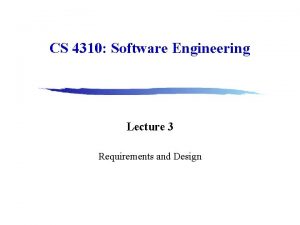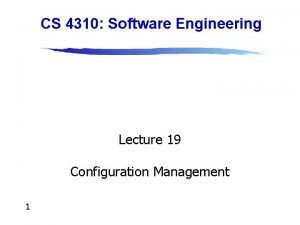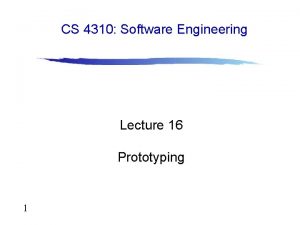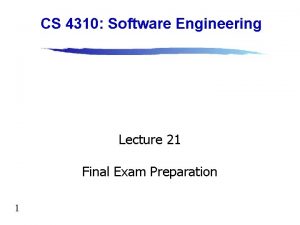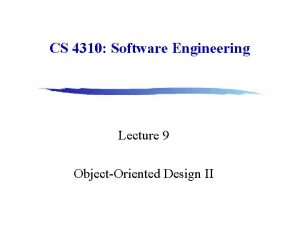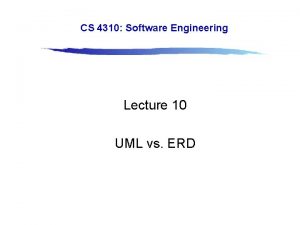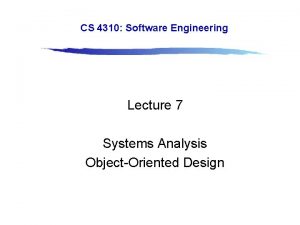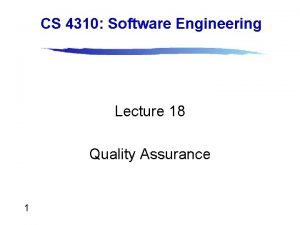CS 4310 Software Engineering Lecture 12 Software Engineering
















































































- Slides: 80

CS 4310: Software Engineering Lecture 12 Software Engineering I Midterm Exam Preparation

Midterm Exam • • • 2 Midterm covers weeks 1 -5 of the course notes Project topics and concepts Requirements Analysis Systems Analysis Object Oriented Analysis The Analysis Document

Week One • Software Development Life Cycles • Phases of Systems Development & the Software Process • Strategies for Systems Analysis and Problem Solving 3

The Software Process Feasibility and Planning Requirements Design Implementation 4 Operation and Maintenance

Software Development Life Cycles (SDLC) • A system development life cycle (SDLC) is a logical process by which systems analysts, software engineers, programmers, and end-users build information systems and computer applications to solve business problems and needs. • It is sometimes called an application development life cycle. The SDLC usually incorporates the following general-purpose problem solving steps: — Planning — Analysis — Design — Implementation — Support 5

Example SDLC • Waterfall Model — The Waterfall model encourages software development to proceed in successive stages including operational specifications, coding, parameter testing, assembly testing, shakedown and system evaluation. • FAST Model — Uses a combination of techniques 6

Life Cycle Phases Requirements Definition System and Software design Programming and Unit Testing Integration and System Testing 7 Operation and Maintenance

What is a Methodology? A methodology is the physical implementation of the logical life cycle that incorporates: (1) step-by-step activities for each phase (2) individual and group roles to be played in each activity (3) deliverables and quality standards for each activity (4) tools and techniques to be used for each activity. 8

Systems Analyst Systems analysis is the study of a business problem domain for the purpose of recommending improvements and specifying the business requirements for the solution. Systems design is the specification or construction of a technical, computer-based solution for the business requirements identified in a systems analysis. 9

Modern Structured Analysis • Is a process-centered technique that is used to model business requirements for a system. • The models are structured pictures that illustrate the processes, inputs, outputs, and files required to respond to business events. • Structured analysis introduced an overall strategy that has been adopted by many of the other techniques – model-driven development. 10

Prototyping is an engineering technique used to develop partial, but functional versions of a system or applications. When extended to system design and construction, a prototype can evolve into the final, implemented system. Two ‘flavors’ of prototyping are applicable to systems analysis: Feasibility prototyping is used to test the feasibility of a specific technology that might be applied to the business problem. Discovery prototyping (sometimes called requirements prototyping) is used to ‘discover’ the users’ business requirements by having them react to a ‘quick-and-dirty’ implementation of those requirements. 11

Joint Application Development (JAD) • Joint application development (JAD) uses highly organized and intensive workshops to bring together system owners, users, analysts, designers, and builders to jointly define and design systems. • A JAD-trained systems analyst usually plays the role of facilitator for a workshop. This workshop may replace months of traditional interviews and follow-up meetings. 12

Object-Oriented Analysis (OOA) Data and the processes that act upon that data are combined or encapsulated into things called objects. The only way to create, delete, change, or use the data in an object (called properties) is through one of its encapsulated processes (called methods). Object-oriented analysis (OOA) techniques are used to: (1) Study existing objects to see if they can be reused or adapted for new uses, and to (2) Define new or modified objects that will be combined with existing objects into a useful business computing application. 13

Week Two • The Engineering Process • Standards and Documentation • Requirements Specifications 14

What is Software? Executable code in itself is not a saleable or deliverable product. Without data structures and documentation to support it, rarely would it function and it would most certainly be difficult to maintain. Software = code + data structures + documentation 15

How SDLCs Work The requirements phase contains all those activities in which you determine what the system or software is supposed to do. Design analysts then take over and use those requirements to formulate the system or software design. Programmers take the initial designs, in conjunction with the requirements and begin to "make it happen". The test phase is concerned with testing the reliability of what has been created. 16

Standards and Documentation • Most of the SDLC models utilize some set of standards and documentation. • For a long time the military and industry used Mil-Std 498. This body of standards and documentation was canceled a couple of years ago. The Mil-Std 498 was document intensive and followed the traditional Waterfall model of software development. • It has been replaced by a series of new standards such as the International Standards Organization (ISO) 9000 and the Capability Maturity Model (CMM). 17

International Standards Organization (ISO) 9000 • The ISO 9000 is a series of five standards that apply to a range of industries that includes software engineering. • The standards focus on documenting the process and measuring the results of implementing those processes. 18

Capability Maturity Model (CMM). • CMM is concerned with the level of maturity exhibited in a software development organization. • The model is broken down into five levels; each level contains a set of key practices and attributes that are characteristic of software organizations at that level of maturity. • CMM is process oriented. 19

Why Use Standards? • Standards are necessary to ensure that everyone uses the same naming conventions and programming constructs. • Consistency in programming reduces maintenance costs. • Documentation in programming usually consists of a software requirements document or specification (SRD or SRS), a software design document (SDD), and a wide range of other documentation. 20

Requirements Document You should be familiar with what this document is used for but you DO NOT have to know what data or sections it contains or anything about the format information. 21

Software Requirements Specifications Requirements state what the system should do Design describes how it does this. The requirements document is the official statement of what is required of the system developers. It should include both a definition and a specification of the requirements. 22

Two main Types of Requirements set out what the system should do and define constraints on its operation and implementation Functional requirements set out services the system should provide. These are mandatory for system functionality. Non-functional requirements constrain the system being developed and specifies non-functional characteristics. 23

Week Three • Data Modeling and Flow Diagrams • Entity Relationship Models • Mapping Analysis to Design 24

Data Modeling A way to structure unstructured problems is to draw models. A model is a representation of reality. Just as a picture is worth a thousand words, most system models are pictorial representations of reality. Models can be built for existing systems as a way to better understand those systems, or for proposed systems as a way to document business requirements or technical designs. 25

Logical and Physical Models What are Logical Models? Logical models show what a system ‘is’ or ‘does’. They are implementation-independent; that is, they depict the system independent of any technical implementation. As such, logical models illustrate the essence of the system. What are Physical Models? Physical models show not only what a system ‘is’ or ‘does’, but also how the system is physically and technically implemented. They are implementation-dependent because they reflect technology choices, and the limitations of those technology choices. 26

Entities All systems contain data. Data describes ‘things. ’ A concept to abstractly represent all instances of a group of similar ‘things’ is called an entity. An entity is something about which we want to store data. An entity is a class of persons, places, objects, events, or concepts about which we need to capture and store data. An entity instance is a single occurrence of an entity. 27

Attributes The pieces of data that we want to store about each instance of a given entity are called attributes. An attribute is a descriptive property or characteristic of an entity. An attribute’s data type determines its domain. The domain of an attribute defines what values an attribute can legitimately take on. 28

Relationships A relationship is a natural business association that exists between one or more entities. A connecting line between two entities on an ERD represents a relationship. A verb phrase describes the relationship. All relationships are bi-directional, meaning that they can be interpreted in both directions. 29

Relationships… Each relationship on an ERD also depicts the complexity or degree of each relationship and this is called cardinality. Cardinality defines the minimum and maximum number of occurrences of one entity for a single occurrence of the related entity. Because all relationships are bi-directional, cardinality must be defined in both directions for every relationship. 30

Data Flow Diagram (DFD) A Data Flow Diagram (DFD) is a single process bubble with all inputs to and outputs from, the system represented. Commonly called a ‘Context Diagram’, it includes providers of data to the desired system and users of the information formulated from that data as external entities. 31

Components of the DFD External entities Processing steps Data stores or sources Data flows 32

Example DFD Rejection Application Completed form Receive application Evaluate application Offer 33

Process Specifications A Process Specification is a textual description of the data process or flow. Every process on a DFD should have a corresponding process description. Process Specifications can be documented in a variety of ways. 34

Process Specification Consider a DFD that contains a process called ‘Process Student Registration. ’ Assume that there is also a diagram that represents the details of this process - processes such as — ‘Verify Registration On Time, ’ — ‘Verify Prerequisites Met, ’ — ‘Verify Slot Available, ’ — ‘Place on Standby List’ — ‘Record Registration’ 35

Process Specification… The ‘Process Student Registration’ specification could contain a general description, such as the following: PROCESS STUDENT REGISTRATION This process receives registration requests from students, ensures that they are valid, and records them in the database. 36

Process Specification… Here is a sample Process Description for ‘Verify Registration On Time’: Verify Registration On Time Get the Class Start Date from the Class table. Subtract 14 from the Class Start Date to determine Latest Registration Date. Get the Date the Registration Request was received by the Registrar from the Registration Request. If this date is not on the request, return it as incomplete. If the Date the Registration Request was received is later than the Latest Registration Date, reject the Registration Request as late. 37

Structured English (sometimes called Pseudocode) resembles a simple narrative, but ‘structures’ conditional logic in such a way as to make it clear. The advantage of Structured English is that it is easily understood by a variety of users while providing the specificity that software developers require. 38

Structured English… When a student tries to register for a class, the following process is followed: For each Form 17 If Class Date is not two weeks or more away Reject as too late Else Check to see if Student has prerequisites for Course If Prerequisites not met Reject as Prerequisites not met Else Check for Available Slots If Slots not Available Reject for No Room Else Register Student 39

Entity Relationship Diagrams (ERD) Entity Relationship Diagrams (ERDs) show the system entities and their relationships with other entities. Data process is not represented. Data Flow Diagrams (DFDs) represent all data that is input, stored, transformed, and produced within a software application. They represent data in a logical way that can be translated into any number of physical structures. 40

Entity-Relation Diagram An entity A relation between entities An entity or relation attribute 41

Example ERD Book Describes Catalog record Short title 42 Author of Editor of Is about Control numb Creator Subject heading

Building ERD’s in Analysis Assume we are told that an employee works for one branch (part of a company) and that each branch can have many employees. The relationship between employee and branch would look like this: 43

Building ERD’s in Analysis… An employee can be a fire marshal for several branches, and each branch can have only one fire marshal. You would model this relationship like this: 44

Data Definitions and Stores Data dictionaries are lists of all of the names used in the system models. Descriptions of the entities, relationships and attributes are also included. Every Data Flow and Data Store View must be defined in terms of its data elements. These definitions are stored in the Data Dictionary. 45

Data Dictionaries A data dictionary is a list of names used by the system • Brief definition (e. g. , what is "date") • What is it (e. g. , number, relation) • Where is it used (e. g. , source, used by, etc. ) Read pages 39 -43 for more detailed examples of data stores and definitions. 46

Mapping Analysis to Design Terms listed on pages 44 -46 of your class notes: Architecture Functional Independents Transaction Analysis Requirements Traceability Control Couple Verification Modularity Transform Analysis Design Patterns Boss Module Data Couple Validation You should be familiar with the terms in red. 47

Architecture associates the system capabilities identified in the requirements specification with the system components that will implement them. Exploring architecture helps to: • Analyze the effectiveness of the design in meeting its state requirements. • Consider architectural alternatives. • Reduce the risk associated with the construction of the software. 48

Modularity is the organization of software into separately named and addressable components. Modularity is the single attribute of software that allows a program to be intellectually manageable. 49

Functionally Independent Modules with: — single-minded functions — simple interfaces — easy to develop and maintain — Reusability … are considered functionally independent. Ideally all modules within a design should be functionally independent, although this goal is unrealistic. 50

Design Patterns A Design Pattern names, abstracts, and identifies the key aspects of a common design structure that make it useful for creating a reusable design. A Pattern must identify the components, their roles, and their relationships. A Design Pattern leads to reusability of software by allowing previously developed structures to be used to solve similar, but new, problems. 51

Requirements Traceability describes the ability to identify where each of the lowest level requirements are implemented within a design. Essentially, primitive level processes can be mapped to the specific module where that process is implemented. Requirements Traceability supports change management throughout the development process. 52

Verification The term Verification refers to the concept of determining that we are building the product correctly. It assumes that the requirement is stated and interpreted properly and focuses on the way we have implemented that requirement. 53

Validation The term Validation means to determine whether we are building the correct product. Validation ascertains that we correctly understand the requirement. 54

Analysis Document You should be familiar with what this document is used for but you DO NOT have to know what data or sections it contains or anything about the format information. 55

Week Four • Traditional versus OO Development • Object Oriented Analysis • Unified Modeling Language (UML) 56

Shifting from ERD to OOD 57 ERD Term UML Term Entity Class Instance of an entity Object Relationship Association Attributes

Objects An object is like a module that contains both data and the instructions that operate on those data. Data are stored in instance variables; the instructions for their manipulation are defined inside methods. 58

Messages and Methods A message is a request to an object to act in a specified way. The message may contain information to clarify the request, but the sender does not need to know how the receiver will carry out the request; it only need to know that it is carried out. 59

Classes and Instances A class is a description of an object. It contains data and methods that determine the common characteristics of a set of objects. It is really an abstract definition of an object. 60

Object Oriented Analysis Object based programming involves four general design concepts and can be remembered by thinking of "A PIE. “ Abstraction Polymorphism Inheritance Encapsulation See pages 52 - 53 for definitions of the above terms. 61

Abstract Data Types (ADT) An abstract data type (ADT) is a data type defined only in terms of the operations that may be performed on objects of the type. Programmers are allowed to examine and manipulate objects using only these operations and they are unaware of how the objects are implemented in the programming language. 62

Programmer-Defined Classes A class is an actual representation of an ADT. It provides implementation details for the data structure used and the operations the class provides. 63

The Three Steps of OOA 1. Use-case modeling —Determine how the various results are computed by the product (without regard to sequencing) —Largely action-oriented 2. Class modeling (“object modeling”) —Determine the classes and their attributes —Purely data-oriented 3. Dynamic modeling —Determine the actions performed by or to each class —Purely action-oriented 64

Unified Modeling Language A variety of modeling languages have evolved over time in support of traditional systems. We previously looked at some of the most common of these. In the OO world a single unified standard is winning out as the universal syntax for modeling. That syntax is defined by the Unified Modeling Language (UML). 65

Types of UML Diagrams 1. Use Case 2. Class Diagram 3. Interaction Diagram (including both the Sequence Diagram and the Collaboration Diagram) 4. State Diagram 5. Activity Diagram 6. Component Diagram 7. Deployment Diagram Read description on pages 61 – 63 in your class notes 66

Use Case and Class Modeling • Extract classes and their attributes • Represent them using an entity-relationship diagram • Deduce the classes from use cases and their scenarios • Often there are many scenarios 67

Class Diagram Applet generalization Hello. World paint() 68 dependency Graphics

Use Case Scenarios A Use Case represents an interaction between an external entity and the target system. The processing represented by that Use Case is defined in a Use Case Scenario. A Use Case Scenario focuses on a single Use Case and a specific event associated with on occurrence of that Use Case. It lists the individual steps involved to accomplish the function represented. If the steps would be different under different conditions, a different Use Case Scenario would be developed for each potential set of conditions. 69

Use CASE Scenario 70

Actor and Use Case Diagram Book. Borrower Borrow book 71 • An actor is a user of a system in a particular role. • An actor can be human or an external system. • A use case is a a task that an actor needs to perform with the help of the system.

Scenario Example Use case: Generic description of overall functionality Scenario: Instance of a use case 72

Use Cases for Borrowing Books Borrow copy of book Borrower Extend loan 73 Return copy of book Reserve book

Week Five • Object Oriented Design • Coupling and Cohesion 74

Transform Analysis Transform analysis is an examination of the DFD to divide the processes into those that: — perform input and editing, — those that do processing or data transformation (e. g. , calculations), — and those that do output. Know the meaning of Transform Analysis. You do NOT have to know the 7 -step process on pages 66 and 67. 75

Types of Design Objects Read descriptions on pages 67 – 68 in the class notes Design Objects: All objects in the System Design Entity Objects: The objects that represented actual data within the business domain. Interface Objects: It is through interface objects that the users communicate with the system. Control objects: Contain behavior that does not naturally reside in either the interface or entity objects. 76

Coupling and Cohesion are the two primary measure of the quality of design for both OO and traditional systems. Coupling is a measure of the interdependence between modules - how much data and control needs to be passed to enable your overall design to function. Coupling should be minimized. 77 Cohesion is a measure of the strength of association of the components within a module - did we package code that belongs together. Cohesion should be maximized.

Coupling and Cohesion… Have an understanding of what Coupling and Cohesion are by reading pages 69 – 75 but you do NOT need to know the different types of Coupling and Cohesion or how to apply the concepts. 78

Software Design Specification You will NOT be asked question about the Software Design Specification that appears that the end of the week five notes. 79

Midterm Exam Specifics • • 15% of your total grade for the class You will have the entire class time (1 hour, 50 min) You will need to create 1 simple ERD You will need to create 1 simple DFD Short answer and multiple choice type questions NO fill-in-the-blank No True/False Good Luck! 80
 Sisa
Sisa 01:640:244 lecture notes - lecture 15: plat, idah, farad
01:640:244 lecture notes - lecture 15: plat, idah, farad Software engineering lecture notes
Software engineering lecture notes Financial engineering notes
Financial engineering notes Foundation engineering lecture notes
Foundation engineering lecture notes Professional ethics in engineering notes
Professional ethics in engineering notes What is system in software engineering
What is system in software engineering Forward engineering in software engineering
Forward engineering in software engineering Software project management lecture notes
Software project management lecture notes Lecture presentation software
Lecture presentation software Software maintenance in software engineering ppt
Software maintenance in software engineering ppt Who invented software engineering
Who invented software engineering What is software metrics in software engineering
What is software metrics in software engineering Example of software crisis
Example of software crisis Software measurement and metrics in software engineering
Software measurement and metrics in software engineering Real time software design in software engineering
Real time software design in software engineering Design principles in software engineering
Design principles in software engineering Engineering elegant systems: theory of systems engineering
Engineering elegant systems: theory of systems engineering Elegant systems
Elegant systems Forward and reverse engineering
Forward and reverse engineering Project procurement management lecture notes
Project procurement management lecture notes Lecture about sport
Lecture about sport Lecture on healthy lifestyle
Lecture on healthy lifestyle Existential nihilism
Existential nihilism Meaning of this
Meaning of this Randy pausch last lecture summary
Randy pausch last lecture summary Tensorflow lecture
Tensorflow lecture Theology proper lecture notes
Theology proper lecture notes Strategic management lecture
Strategic management lecture Geology lecture series
Geology lecture series Social psychology lecture
Social psychology lecture In text citation for a lecture
In text citation for a lecture Public sector accounting pdf notes
Public sector accounting pdf notes Eurocode lap lengths
Eurocode lap lengths Magnetism
Magnetism Physics 111 lecture notes
Physics 111 lecture notes Physics 101 lecture
Physics 101 lecture Physical science lecture notes
Physical science lecture notes Power system dynamics and stability lecture notes
Power system dynamics and stability lecture notes Natural language processing
Natural language processing Microbial physiology and metabolism lecture notes
Microbial physiology and metabolism lecture notes Mechatronics lecture notes
Mechatronics lecture notes Ternology
Ternology Les différents types de lecture au primaire
Les différents types de lecture au primaire Instruction de lecture
Instruction de lecture Aronautique
Aronautique Lecture title
Lecture title Slidetodoc
Slidetodoc Bjt
Bjt Extension lecture meaning
Extension lecture meaning Résumé de chapitre 49 le dernier jour d'un condamné
Résumé de chapitre 49 le dernier jour d'un condamné Tegrity lecture capture
Tegrity lecture capture Types of social letter
Types of social letter Transistor lecture
Transistor lecture Harvard referencing lecture
Harvard referencing lecture How to write a recipe review
How to write a recipe review The parsec lecture tutorial answers
The parsec lecture tutorial answers Ofdm lecture notes
Ofdm lecture notes Basic semiconductor physics:
Basic semiconductor physics: Milieu clark et lubs
Milieu clark et lubs Land use planning '' lecture notes
Land use planning '' lecture notes Grille de lecture systémique
Grille de lecture systémique Merci pour votre attention
Merci pour votre attention Texte lecture pas à pas
Texte lecture pas à pas Renoir la lecture
Renoir la lecture Relecture automatique de formulaires
Relecture automatique de formulaires Lecture diction définition
Lecture diction définition Les themes traites dans la ficelle
Les themes traites dans la ficelle La compréhension en lecture giasson résumé
La compréhension en lecture giasson résumé Jane_ixx
Jane_ixx Project management lecture notes doc
Project management lecture notes doc Membership function fuzzy logic
Membership function fuzzy logic Fuzzy logic lecture
Fuzzy logic lecture Trois femmes puissantes lecture cursive
Trois femmes puissantes lecture cursive Lecture notes on homiletics
Lecture notes on homiletics Forensic psychology lecture
Forensic psychology lecture Financial management lecture
Financial management lecture Image processing lecture notes
Image processing lecture notes Intermediate microeconomics lecture notes
Intermediate microeconomics lecture notes Divine principle 3 hour lecture
Divine principle 3 hour lecture Xxx fib
Xxx fib












































